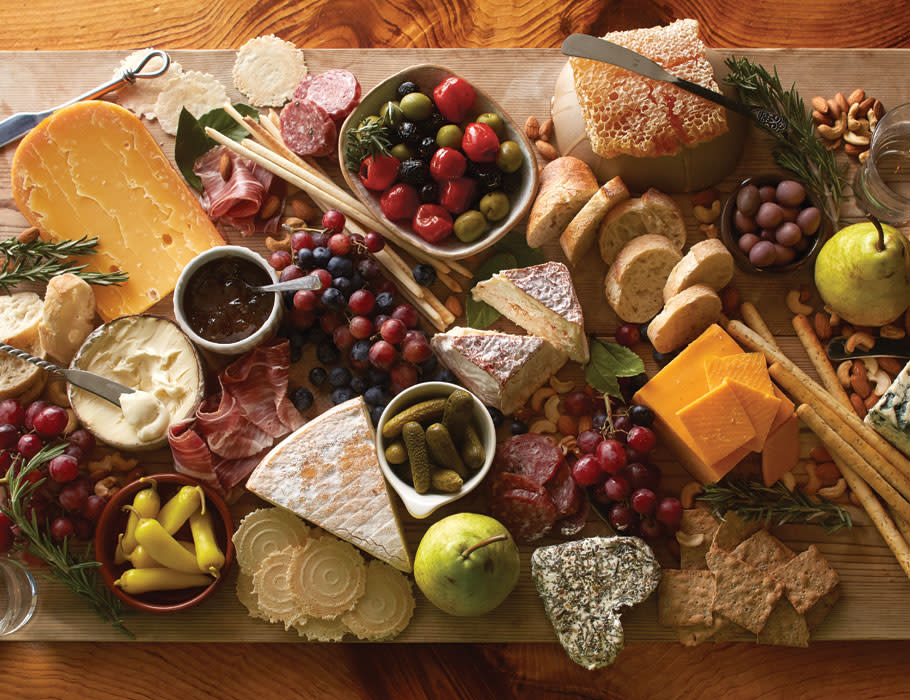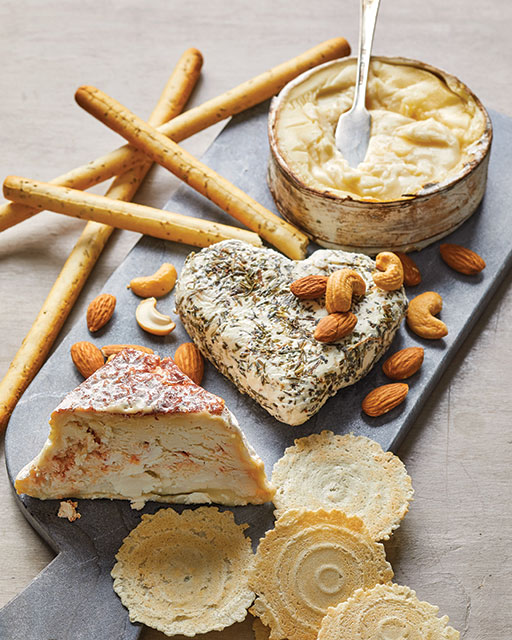How to Create the Ultimate Cheese Board
Our local expert on all things cheese, C.J. Bienert, helps us put together the prettiest, picture-perfect cheese board with a variety of textures and flavors. Then, with his suggestions in hand, have some fun creating your own photo-worthy cheese board.
by Pamela Kileen

Visually stunning, excitingly appetizing, and with no cooking or careful timing required, there's almost nothing better for a get-together than an expertly assembled cheese board. Here you'll find easy rules of thumb for putting together a spread to make your loved ones swoon.
Our local cheesemonger, Charles (C.J.) Bienert, ACS CCP has earned the distinguished title of Certified Cheese Professional (CCP) through the American Cheese Society (ACS). His journey regarding “all things cheese” started almost 20 years ago. It’s led him on an exploration around the world encompassing every aspect of cheese and cheesemaking. He’s visited dairies, tried his hand at cheese production, and has ventured into the business of selling cheese and running a cheese-centric restaurant. C.J., along with his wife, Kari, are owner/operators of The Cheese Shop and The Cheese Bar in Des Moines, IA.
Without further ado, here are C.J.'s expert tips for a cheese board your guests will want to write home about.
Step 1: Select Your Cheeses
Less is More
For your basic, well-rounded cheese board, C.J. recommends selecting four or five cheeses, one from each of the texture categories covered in our Cheese Primer, plus a small amount of blue to round things out.
Go Seasonal
Choose cheeses according to the season. This has to do with what a cow, sheep, or goat is grazing on at the time of milking. Spring cheeses tend to be more mellow, summer ones are more floral, fall cheeses more grassy, and winter ones are more rich and creamy. And some cheeses are only available at certain times of the year.
Heavy vs. Light
Factor in when you’ll be serving the cheese – if it’s before dinner, opt for lighter cheeses, if it’s after dinner go in one of two directions: serve just one rich, creamy cheese; or go for more full-flavored cheeses.
Theme
Once you've mastered the basics, try creating themed boards — they could be based on regions (France, Italy, etc.), milk types (all goat cheese with different age ranges), etc.
Step 2: Select Your Condiments
More is More
Condiments really enhance a cheese board. They add sweet, savory, and salty elements, plus a variety of textures, as well as fresh and dried components.
Crackers & Bread - Offer a range of crackers and/or bread, such as water crackers, baguette slices, fruit toasts, etc.
Fruit - Include both fresh and dried fruit of your choosing, such as figs, apple, pear, dried apricots, dried cherries, etc.
Nuts - Nuts add flavor and texture (can be candied or spiced or not – your choosing).
Olives & Pickles - For a little brininess, add a sprinkling of olives of your liking and pickles, such as cornichons or peppadews.
Spreads - Spreads, like jams, mustards, or honey, not only pair well with cheese, they lend sweet and savory aspects.
Flourish - Fresh herb sprigs, like rosemary or thyme add some visual enhancement. Adding a few flowers, especially if they’re edible, lends beauty and a different flavor component.
Charcuterie - A small amount of charcuterie adds flavor and more variety to your board – but to be a purist, let the cheese be the star of the board and leave the charcuterie off.
Should You Slice Cheeses for Serving?
Don't cut the cheese while assembling your board — you don’t want it to dry out. Cutting a few slices is OK.
Leave rinds on — not only are they beautiful, they’re edible and offer a lot of flavor (except the hard, waxy kind)
Cheese Board Success Tip: Talk To Your Cheesemonger
Now that you know a thing or two about cheese, it’s time to visit your cheesemonger and have a conversation so they can best direct you. Remember there really are no rules. Just keep in mind, these are some suggestions from C.J.’s voice of experience.
- Give your cheesemonger an idea of the type of party you’re having – how many people, the menu, the time of day and year.
- As a reference point, let your cheesemonger know what kind of cheese you like.
- Ask for samples of different cheeses to help you with your selections (a good cheesemonger should absolutely give you samples).
- Don’t be afraid to ask questions about cheeses, cheese boards, knives, storage, etc.

Learn more about specialty cheeses with our Cheese Primer.
Check out The Cheese Shop's website for gift boxes & Cheese Club, now shipping to IA, MN, ND, SD, and WI.
Add a homemade touch to your next cheese board by making your own Port Wine Cheese Log and Black Pepper Crackers.
Product Recommendations
Interested in cooking? Need some supplies?
Check out some of the tools we like. All products featured on Cuisine at Home are independently selected by our editors; we may earn an affiliate commission from qualifying purchases through our links.